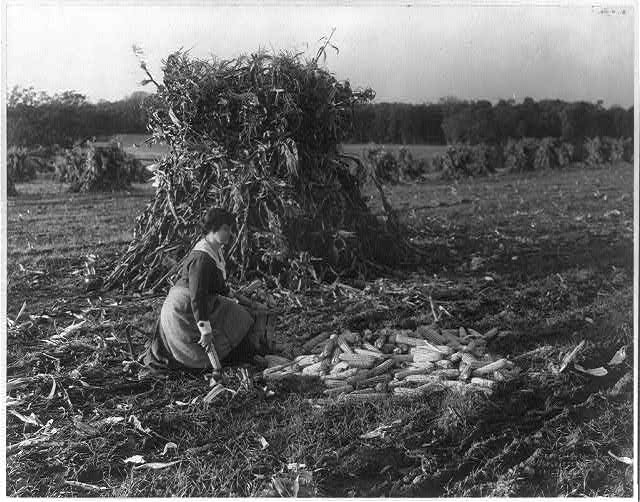Nothing but Corn Bread
“At first we had very little to eat, nothing but corn bread at first, later we began to raise cow peas, and afterwards my father made a fine vegetable garden.”
Caroline Ernst, THE QUARTERLY 1898 (arrived in Texas in 1831, eleven years old)

German settlers to the Texas Hill Country left a civilized life behind to make a new life in the Texas wilderness, and they were shocked at how wild Texas was in the early 1800s. The first group arrived when Texas was a Mexican state under rule of a government in Mexico City, one thousand miles away.
Most of the household items they used in European society were not suitable for the tree covered hills of central Texas. Woolen clothing, bed linens now molded from the ocean voyage, and delicate china. And wheat for bread was nonexistent. They lived in a place where “beef could be raised with less trouble than corn.”
“In Texas nothing was the same. The Kartoffel [Irish potato], diet staple of the Germans, along with wheat and rye flour, was not at first available. Corn, considered food for livestock in Germany, had to be their daily bread stuff and the ubiquitous sweet potato, an unacceptable substitute for their beloved white potato.”
Crystal Sasse Ragsdale, THE GOLDEN FREE LAND

“It used to amuse me when we rode up to a house at night and called for a meal, to hear the woman sing out to a boy, “Run to the field and bring two or three ears of corn. I want to make some bread for the gentlemen’s supper.”
A. A. Parker, Esq., TRIP TO THE WEST AND TEXAS, 1834
In his journals, Mr. A. A. Parker could only mention three places that he found wheat bread during his travels through Texas. He recorded fine herds of cattle and a comfortable dwelling consisting of a one-room log cabin with the main fare being “cornbread, meat and sweet potatoes.” Wheat flour was grown elsewhere and imported to the area, making it too costly for most newly arrived settlers.

“They boiled it and fried it and roasted it, either by standing the husked ears on end before the fire and turning them till browned all around or burying them husk and all in hot ashes–the sweetest way green corn was ever cooked.”
Noah Sithwick, 1827
In researching recipes for my historical cookbooks, cornbread seemed to be one of the most common staples that has been around for generations. There are so many variations, which I’ve included in both cookbooks, and of all the ones I discovered the one listed below was an easy winner. I like to use ‘sweet’ Vidalia onions for this recipe. Maybe it was the addition of finely diced onions that makes it so moist, and this version has been modernized with the use of self-rising cornmeal. However, I’m sure the taste was just as delicious in the previous century.
Sweet Onion Corn Bread
- 2 cups self-rising white cornmeal
- 1 tablespoon sugar
- 1 teaspoon baking powder
- 2 cups milk
- 2 tablespoons bacon drippings (or oil)
- 1 large egg, slightly beaten
- 2 cups sweet onion, finely chopped
Preheat oven to 350 degrees F. Grease a 9-inch cast iron wedge pan (or cast iron skillet words well too). In a large bowl combine the cornmeal mix, sugar, baking powder, milk, grease or oil, and egg until well blended (the batter will be thin). Add onions, stirring until well blended. Pour the batter into the prepared pan and bake until golden brown, about 40 minutes (maybe longer if using a skillet). Toothpick inserted in the middle should come out clean. Let cool before serving.
My newest release, A NEW FATHERLAND, with German author Manuela Schneider, is now available in eBook, print or hardcover. Inspired by true accounts of German immigrants to Texas, the historical fiction story follows two families. Best deal, read it for FREE on Kindle Unlimited.
END OF THE TRAIL EATS includes the cornbread recipe above along with other authentic dishes and the history of the cattle trails and Cowtown era.
Link to Amazon Author Page Click Here
Natalie Cline Bright is a blogger, speaker, and author of over 20 books for kids and adults. Her and her husband own a cow/calf operation in the Texas Panhandle.


